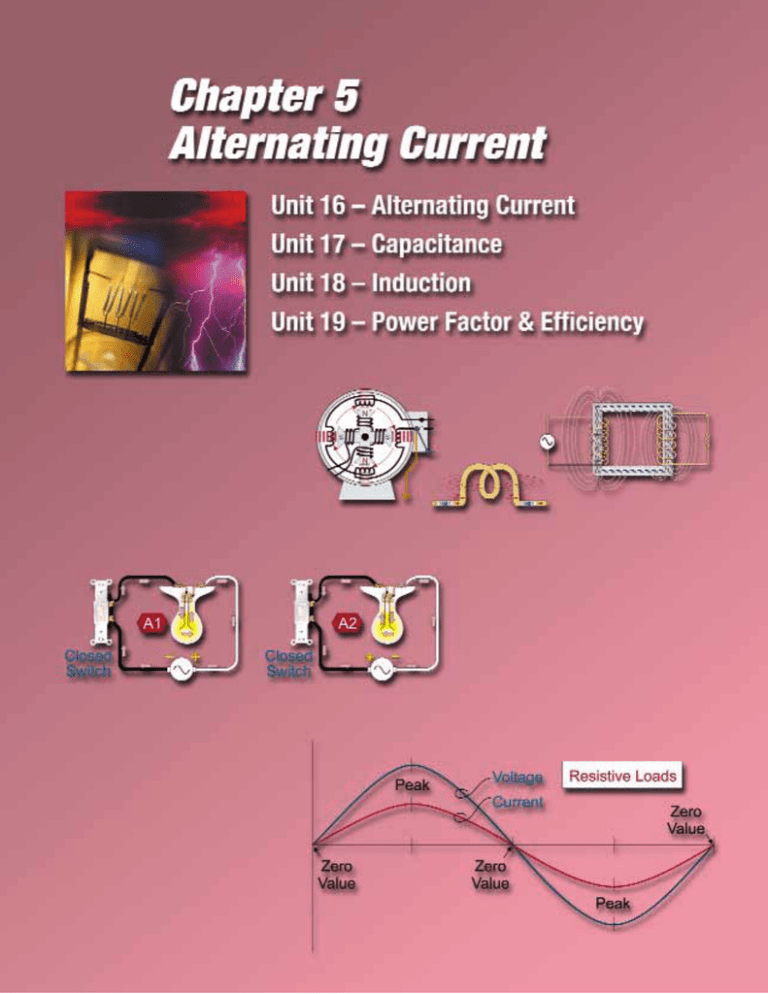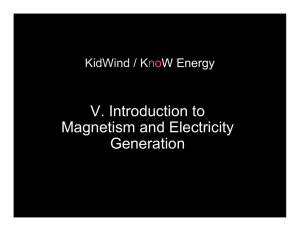Sample Pages
advertisement

Introduction Because ac current is inexpensive to transmit compared to dc current, ac has become the dominant form of electricity in our modern infrastructure. In the early days of commercially available electric power, dc was dominant. But, economics won out. Applying ac safely or effectively, however, requires an understanding of certain concepts that border on the complex. All of those concepts build on what you have already learned. 16.1 Current Flow In order for current to flow, a circuit must be a closed loop and the power supply must apply sufficient electromotive force to cause the electrons to move. The movement of the electrons themselves does not produce any useful work; it’s the effects that the moving electrons have on the loads they flow through that are important. The effects of electron movement are the same regardless of the direction of the current flow. Figure 16–1 electronic equipment, where only direct current can perform the desired function. This is accomplished by rectifying ac to dc to power these electronic loads. Figure 16–2 16.2 Why Alternating Current is Used Alternating current is primarily used because it can be transmitted inexpensively due to the ease of transforming to high-transmission voltage and then transforming this voltage back to low distribution voltage. In addition, alternating current is used when direct current is not suitable for the application. Direct-Current Use. There are other applications however, particularly inside Figure 16–1 195 Chapter 5 – Alternating Current Basic Electrical Theory 16.1 Current Flow 16.5 Waveform In order for current to flow, a circuit must be a closed loop and the power supply must apply sufficient pressure to cause the electrons to move. The effects of electron movement are the same regardless of the direction of the current flow. Direct-Current Waveform 16.2 Why Alternating Current is Used Alternating current is primarily used because it can be transmitted inexpensively due to the ease of transforming to high-transmission voltages and then transforming this voltage back to lower distribution voltages. Unit 16 – Summary A direct-current waveform displays the direction (polarity) and magnitude of the current or voltage. Alternating-Current Waveform The waveform for alternating-current circuits displays the level and direction of the current and voltage for every instant of time for one full revolution of the rotor. 16.6 Sine Wave 16.3 How Alternating Current is Produced Sinusoidal Waveform Faraday’s experiments revealed that when a magnetic field moves through a coil of wire, the lines of force of the magnetic field cause the electrons in the wire to flow in a specific direction. When the magnetic field moves in the opposite direction, electrons in the wire flow in the opposite direction. Electrons flow only when there is motion of the conductors relative to the magnetic field. The waveform for alternating-current circuits is symmetrical with positive above and negative below the zero reference level. For most alternating-current circuits, the waveform is called a sine wave. Nonsinusoidal Waveform A nonsinusoidal waveform is created by what are called nonlinear loads being supplied by the circuit; these could distort the sine wave. 16.4 AC Generator A simple ac generator consists of a loop of wire rotating between the lines of force between the opposite poles of a magnet. The halves of each conductor loop travel through the magnetic lines of force in opposite directions, causing the electrons within the conductor to move in a given direction. The magnitude of the voltage produced is dependent upon the number of turns of wire, the strength of the magnetic field, and the speed at which the coil rotates. 16.7 Nonsymmetrical Waveform In generators that produce large quantities of electricity, the conductor coils are stationary and the magnetic field revolves within the coils. Use of electromagnets permits the strength of the magnetic field, and thus the lines of force, to be modified, thereby controlling the output voltage. 16.9 Phase The combination of alternating current and direct-current waveforms results in a nonsymmetrical waveform. 16.8 Frequency The number of times the rotor turns in one second is called the frequency. Frequency is expressed as Hertz (Hz) or cycles per second. Phase is a term used to indicate the time or degree relationship between two waveforms, such as voltage-to-current or voltage-to-voltage. When two waveforms are in step with each other, they are said to be in-phase. 201 Chapter 5 – Alternating Current Basic Electrical Theory Unit 16 – Practice Questions 16.1 Current Flow 1. The movement of electrons themselves does not produce any useful work; it’s the effects that the moving electrons have on the loads they flow through that are important. (a) True (b) False 16.2 Why Alternating Current is Used 2. Alternating current is primarily used because it can be transmitted inexpensively. (a) True (b) False 16.3 How Alternating Current is Produced 3. Faraday discovered that the lines of force of the magnetic field cause the electrons in the wire to flow in a specific direction. When the magnetic field moves in the opposite direction, electrons flow in the opposite direction. (a) True (b) False 16.4 AC Generator 4. A simple ac generator consists of a loop of wire rotating between the lines of force between the opposite poles of a magnet. (a) True (b) False 5. In ac generators that produce large quantities of electricity, the conductor coils are stationary and the magnetic field revolves within the coils. (a) True (b) False 6. Output voltage of a generator is dependent upon the _____. (a) number of turns of wire (b) strength of the magnetic field (c) speed at which the coil rotates (d) all of these 16.5 Waveform 7. A waveform image is used to display the level and direction of current, but not voltage. (a) True (b) False 8. The waveform for ac circuits displays the level and direction of the current and voltage for every instant of time for one full revolution of the rotor. (a) True (b) False 203



